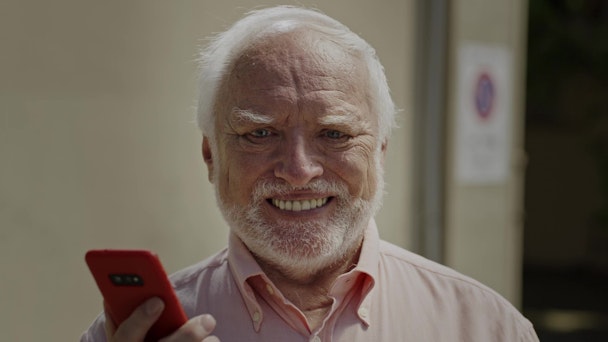The man behind the meme: meet Hide The Pain Harold
The Drum chats with one of the internet’s most recognizable faces, finding out what it’s like to become an unwitting online sensation and hearing about what the advertising world has to offer him.

András Arató AKA ‘Hide the pain Harold’ in the Vodafone commercial / We Are Social
András Arató (aka Hide The Pain Harold) was born in 1945 in Hungary. He worked as an electrical lighting engineer and university lecturer in Budapest, and is married with one son, who is an architect. In 2001, his somewhat normal life took an unexpected turn when a photographer got in touch after stumbling upon his holiday photos on social media: would he be interested in becoming a stock photography model?
“In the course of two years, [the photographer] took several hundred photos and uploaded them to a stock photo website,” says Arató. After a quick Google reverse image search one day, the engineer was shocked to discover that someone in America had picked up his photos, turned them into memes and unleashed them online. “I never wanted to be a meme. I guess nobody wants to be a meme. It was a shocking experience. I wanted to stop it and erase all my pictures, but I realized that this wasn’t possible.”
Then 67 years old, Arató’s look took the web by storm in the form of gifs, images and videos. People gravitated toward his grinning face, which was seemingly unperturbed by any dire circumstances he found himself in. “It took me about five years to accept the situation,” he notes. “But then I said to myself, now that a brand has been built around me, I would be foolish not to use it.” It was at this point that he revealed his true identity to the world and began embracing his newfound fame. “The guy from the memes is me. I’m a human being, I’m a living person and since then it has been unstoppable.”
With fame comes money, right? Well, not necessarily in the internet age. Arató initially didn’t “see a penny” from his viral status. Needing to make the situation more positive (and profitable), he devised a plan to take advantage of his notoriety. Initially believing that all media interest could be handled by him personally from his home computer in Budapest, he soon realized that it was a much greater job than anticipated – everyone wanted a piece of him. He needed a manager.
“We are working hard to create a positive image behind the face because in the beginning there were rude and disgusting memes. Once I embraced it, like yes this is me, we wanted to make it more positive,” he says, adding that he has now been with his Hungarian talent manager for five years.
This change in mindset began bringing a lot more commercial opportunities Arató’s way. He has since starred in a Coca-Cola ad in Hungary, an Enzo spot in Brazil and most recently a tongue-in-cheek campaign by Vodafone Italy and creative agency We Are Social. “It’s an exciting challenge for me because I’ve never appeared in a global campaign before, only nationwide,” he notes.
Internet culture has been trickling its way into brand campaigns over the years, with some ads getting it really right and others coming off as cheesy – the latter will be called out online. The Vodafone ad works because it stays true to what ‘Harold’ is known for. Audiences can relate to it, plus it’s funny.
“We were thinking about iconic smiles that we could use for the commercial and Andras’s was the first and the only one that we wanted,” adds Pietro Borghi, account executive at We Are Social. “He can make a bigger impact because he’s famous for being himself.”
Arató stays tight-lipped on what the future holds in the advertising world for him, but that grinning face says it all – there are projects in the works.
“It’s an unusual career to start as an engineer and end as a meme guy,” he reflects. His thoughts on meme culture? “Memes are a relatively new phenomenon. But in reality, it’s as old as humanity – only the media has changed. In ancient times, people told jokes in the pub and caricatures were printed in newspapers. The only difference is that in the internet age anybody can be a meme.”
Interested in creative campaigns? Check out our Ad of the Day section and sign up for our Ads of the Week newsletter so you don’t miss a story.

